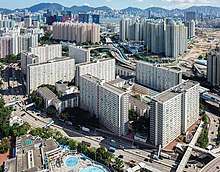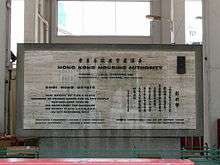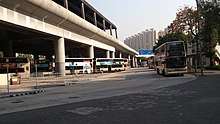Choi Hung Estate
Choi Hung Estate (Chinese: 彩虹邨; lit.: 'rainbow estate') is a public housing estate in Ngau Chi Wan, Kowloon, Hong Kong. It was built by the former Hong Kong Housing Authority (屋宇建設委員會) and is now managed by the current Hong Kong Housing Authority (香港房屋委員會). It received a Silver Medal at the 1965 Hong Kong Institute of Architects Annual Awards.[1]
| Choi Hung Estate | |
|---|---|
 Bird's-eye view (2018) | |
| General information | |
| Location | Ngau Chi Wan Kowloon, Hong Kong |
| Coordinates | 22°20′06″N 114°12′24″E |
| Status | Completed |
| Category | Public rental housing |
| Population | 18,435 (2016) |
| No. of blocks | 11 |
| No. of flats | 7,400 |
| Construction | |
| Constructed | 1963 |
| Authority | Hong Kong Housing Authority |
Location
Choi Hung Estate is located in Ngau Chi Wan and is surrounded by several of eastern Kowloon Peninsula's major roads. To the north is Lung Cheung Road; to the south Prince Edward Road East; to the west Kwun Tong Bypass and to the east Clear Water Bay Road.
History

The Hong Kong government granted the land to the Hong Kong Housing Authority to build a large housing estate in 1958. The blocks of the estate were completed between 1962 and 1964. An opening ceremony was held in 1963 with the presence of then Hong Kong Governor, Sir Robert Brown Black. A signboard commemorating the ceremony is located in the estate's Lam Chung Avenue.
Accommodating nearly 43,000 people, it was the largest public housing estate at the time. It subsequently attracted several prominent visitors, including Richard Nixon in 1964 (who became President of the United States in 1969), Britain's Princess Margaret in 1966, and Princess Alexandra in 1967.[2]
Buildings and facilities
The estate has 11 residential blocks, one car park, and five schools, with various shops and restaurants on the ground floor of each block. Roads in the estate connect the blocks to each other and to major roads.
Residential blocks
| Name | Block | Type of building | Phase | Year of completion |
|---|---|---|---|---|
| Chi Mei House (紫薇樓) | 1 | Old Slab | 1 | 1962 |
| Tan Fung House (丹鳳樓) | 2 | |||
| Luk Ching House (綠晶樓) | 3 | 2 | 1963 | |
| Pak Suet House (白雪樓) | 4 | |||
| Pik Hoi House (碧海樓) | 7 | |||
| Chui King House (翠瓊樓) | 5 | 3 | ||
| Kam Hon House (金漢樓) | 9A | 1964 | ||
| Hung Ngok House (紅萼樓) | 6 | 4 | ||
| Kam Wan House (錦雲樓) | 8 | 5 | ||
| Kam Pik House & Kam Wah House (金碧樓及金華樓) | 9B | 6 |
Public facilities
- car park
- post office
- bus terminus
- 2 markets
Demographics
According to the 2016 by-census, Choi Hung Estate had a population of 18,435. The median age was 48 and the majority of residents (96 per cent) were of Chinese ethnicity. Cantonese was the predominant usual spoken language (93 per cent), followed by other varieties of Chinese excluding Mandarin (4.5 per cent), non-English and non-Chinese languages (2 per cent), Mandarin (0.5 per cent), and English (0.3 per cent).
The average household comprised 2.5 persons. The median monthly household income of all households (i.e. including both economically active and inactive households) was HK$15,290.[3]
Education
Secondary schools
- Choi Hung Estate Catholic Secondary School (彩虹邨天主教中學)
- S.K.H. St. Benedict's School (聖公會聖本德中學)
Primary schools
- CCC Kei Wa Primary School (中華基督教會香港區會基華小學)
- S.K.H. Ching Shan Primary School (聖公會靜山小學)
- S.K.H. Yat Sau Primary School (聖公會日修小學)
Transport

Because the estate is accessible from major roads of Kowloon, the bus network is very convenient.
Buses
- Franchised Buses
| Route Operator | Route Number | Destinations |
|---|---|---|
| Choi Hung Bus Terminus | ||
| KMB | 3D/3M | Tsz Wan Shan |
| 5 | Star Ferry | |
| 14D | Yau Tong | |
| KMB and NWFB | 113 | Kennedy Town (via Central) |
| Choi Hung Estate Access Road | ||
| KMB | 3D | Kwun Tong Yue Man Square |
| 6D | Ngau Tau Kok | |
| 9 | Choi Fook | |
| 11C | Upper Sau Mau Ping | |
| 15A | Ping Tin (via Kowloon Bay Industrial Area) | |
| 21 | Choi Wan | |
| 42C/89D/258D/277P/277X | Lam Tin MTR Station | |
| 62X/259D/N216 | Yau Tong | |
| 89C | Kwun Tong Tsui Ping Road | |
| 74A | Kai Yip Estate | |
| 74C/74D/74X/80X/83X/268C/269C | Kwun Tong Ferry | |
| 89B/89X | Kwun Tong Kwun Tong Station | |
| 91 | Clear Water Bay (via HKUST) | |
| 91M | Po Lam (via HKUST / Hang Hau) | |
| 92 | Sai Kung | |
| 96R | Wong Shek Pier (via Pak Tam Chung) | |
| 889 | Ping Tin | |
| KMB and NWFB | 101R | Kwun Tong Yue Man Square |
| 111 | Ping Shek | |
| N121 | Ngau Tau Kok | |
| 302 | Admiralty/Central/Sheung Wan | |
| KMB and CTB | 671 | Ap Lei Chau Lee Lok Street (via Causeway Bay) |
| Citybus | N29 | Po Lam (via Tseung Kwan O Town Centre) |
| Lung Cheung Road | ||
| KMB | 3D/3M/3P/15A | Tsz Wan Shan |
| 3M/10 | Choi Wan | |
| 6D | Cheung Sha Wan (via Shek Kip Mei) | |
| 9 | Tsim Sha Tsui Mody Road (via Argyle Street) | |
| 10 | Tai Kok Tsui (via Mong Kok) | |
| 11C | Chuk Yuen Estate | |
| 21 | Hung Hom MTR Station | |
| 29M | San Po Kong/Shun Lee Estate | |
| 38 | Ping Tin | |
| Kwai Shing East (via Wah Yuen Chuen) | ||
| 42C | Cheung Hang Estate (via Tsuen Wan) | |
| 62X | Tuen Mun Town Centre | |
| 277E/277P | Sheung Shui/Fanling | |
| 74A | Tai Wo | |
| 74X | Tai Po Centre | |
| 80/80P | Kwun Tong Ferry | |
| 80 | Mei Lam | |
| 80X | Chun Shek | |
| 83X | Shui Cheun O | |
| 89 | Kwun Tong Station | |
| Lek Yuen | ||
| 89B | Sha Tin Wai (via Che Kung Temple) | |
| 89C | Heng On Estate | |
| 89D | Wu Kai Sha Station | |
| 89X | Sha Tin MTR Station (via City One Shatin) | |
| 91/91M/92/96R | Diamond Hill MTR Station | |
| 91 | Clear Water Bay (via HKUST) | |
| 91M | Po Lam (via HKUST / Hang Hau) | |
| 92 | Sai Kung | |
| 95 | Jordan | |
| 96R | Wong Shek Pier (via Pak Tam Chung) | |
| 258D | Po Tin | |
| 259D | Lung Mun Oasis | |
| 268C | Long Ping MTR Station | |
| 269C | Tin Shui Wai Town Centre | |
| 277X | Luen Wo Hui | |
| 889 | Sha Tin Racecourse | |
| KMB and NWFB | 111/N121 | Central Macau Ferry (via Wan Chai) |
| KMB and CityBus | 671 | Diamond Hill MTR Station |
| CityBus | E22/E22A/E22P/E22X/N26/N29 | Tung Chung and Airport |
| E22 | Lam Tin N (via Laguna City) | |
| E22A | Po Lam (via Tiu Keng Leng) | |
| E22P/E22X/N26 | Yau Tong | |
| Kwun Tong Road | ||
| KMB | 1A | Central Sau Mau Ping |
| Star Ferry | ||
| 2A | Lok Wah | |
| Mei Foo | ||
| 11B | Kwun Tong Tsui Ping Road | |
| Kowloon City Ferry | ||
| 11D | Kwun Tong Ferry | |
| Lok Fu | ||
| 13D | Po Tat | |
| Island Harbourview | ||
| 13P | Lai Kok | |
| 14 | Yau Tong | |
| China Ferry Terminal | ||
| 15 | Ping Tin | |
| Hung Hom Ferry | ||
| 16 | Lam Tin Kwong Tin Estate | |
| Mong Kok Park Avenue | ||
| 17 | Kwun Tong Yuet Wah Street | |
| Oi Man(via Ho Man Tin) | ||
| 26 | Shun Tin | |
| Tsim Sha Tsui | ||
| 27 | Shun Tin | |
| Mong Kok | ||
| 28 | Lok Wah | |
| Tsim Sha Tsui | ||
| 29M/42 | Shun Lee | |
| 40 | Laguna City | |
| Tsuen Wan Belvedere Garden | ||
| 93K | Po Lam | |
| 93K/N293 | Mong Kok East MTR Station | |
| 95 | Tsui Lam (via Sau Mau Ping) | |
| 296C/N293 | Sheung Tak | |
| 296C | Sham Shui Po Hoi Ying Estate | |
| Citybus | A22/X22 | Lam Tin MTR Station |
| A22 | Airport | |
| KMB and NWFB | 101 | Kwun Tong Yue Man Square |
| Kennedy Town (via Central) | ||
| KMB and CTB | 107 | Kowloon Bay |
| Wah Kwai | ||
- Minibuses
| Route Number | Destination | |
|---|---|---|
| Green Minibus (New Territories) | 1M/1S | Sai Kung Town |
| 11 | Hang Hau Village (via HKUST) | |
| 11S | Tseung Kwan O Metro City II | |
| 102B | Tseung Kwan O Yuk Ming Court | |
| 102S | Tseung Kwan O East Point City | |
| Red minibus | -- | Mong Kok and Kowloon City |
| Tsuen Wan Market Street |
MTR
The Choi Hung MTR Station on the Kwun Tong Line, which is named after the estate, is in the north of the estate. Exits C3 and C4 are available for access to the estate.
Photography

.jpg)
The estate is photogenic and has become a tourism hot-spot.[4][5] The most photographed view of the estate includes the basketball court and rainbow apartments behind.[6] Some journalists and researchers have been vocal against the growing Instagram popularity of the area, criticising that it is a shallow view of the complex social history of the council estate in Hong Kong, as well as driving away locals who want to use the space.[7][8] Though some locals have also begun selling photos for profit to tourists.[8] It has been suggested that the location is popular not only for the aesthetics, but also because it allows the photographers and selfie-takers to feel as if they are in the middle of the world - compared to the more detached equally-aesthetic Hong Kong skyline shots.[9] In 2017, a photograph of the building was shortlisted for the Arcaid Award, an architecture photography prize.[10]
After featuring in a music video for Korean boyband Seventeen, the fame of the backdrop made the Hong Kong government tourist office begin heavily promoting it.[11]
References
- List of Past HKIA Annual Awards
- "Dignitaries Visiting Public Housing Estates in Earlier Years". Hong Kong Housing Authority. 1 November 2011. Retrieved 13 July 2016.
- "Major Housing Estates". 2016 Population By-census. Census and Statistics Department. Retrieved 18 February 2020.
- Keegan, Matthew. "A Photographer's Guide to Choi Hung Estate". Culture Trip. Retrieved 2019-06-09.
- "The 13 best Instagram photo locations in Hong Kong". Time Out Hong Kong. Retrieved 2019-06-09.
- Travels, Lolapan (2018-05-31). "Choi Hung Estate Hong Kong - A Colourful Photography Hotspot". Lolapan Travels. Retrieved 2019-06-09.
- Wainwright, Oliver (2018-11-23). "Snapping point: how the world's leading architects fell under the Instagram spell". The Guardian. ISSN 0261-3077. Retrieved 2019-06-09.
- "Hong Kong's Instagram-friendly public housing estates". The Independent. 2019-06-08. Retrieved 2019-06-09.
- Hui, Mary (2018-08-09). "Public Housing for Some, Instagram Selfie Backdrop for Others". The New York Times. ISSN 0362-4331. Retrieved 2019-06-09.
- "Amazing architecture: The 20 best photographs of buildings from around the world". The Telegraph. 2017-10-05. ISSN 0307-1235. Retrieved 2019-06-09.
- "Instagram tourists push Hongkongers into the shadows". South China Morning Post. 2019-02-15. Retrieved 2019-06-09.